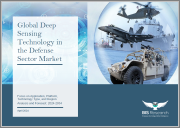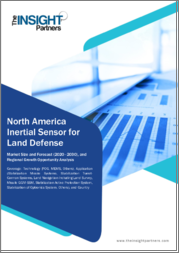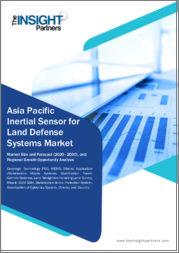
|
시장보고서
상품코드
1469732
세계의 방위 분야 딥 센싱 기술 시장 : 용도별, 플랫폼별, 기술 유형별, 지역별 : 분석과 예측(2024-2034년)Global Deep Sensing Technology in the Defense Sector Market: Focus on Application, Platform, Technology Type, and Region - Analysis and Forecast, 2024-2034 |
||||||
방위 분야 딥 센싱 기술 시장 규모는 상황인식 강화, 적의 움직임, 부대의 배치, 기타 중요한 정보에 관한 데이터 수집에 의한 정보 수집, 센서 기술, 데이터 분석, 인공지능의 진보에 추진되어 큰 성장하고 있습니다.
낙관적 시나리오를 고려하면 2024년 시장 규모는 173억 4,000만 달러로 향후 복합 연간 성장률(CAGR) 6.35%로 확대될 예정이며, 2034년에는 320억 7,000만 달러에 이를 것으로 예상됩니다.
이러한 긍정적인 요인에도 불구하고 시장은 연구 개발, 조달에 많은 투자가 필요하고 복잡한 하드웨어, 소프트웨어 및 네트워크 구성 요소가 필요하다는 것과 같은 장애물에 직면 해 있습니다. 그러나 드론, 무인지상차량(UGV), 무인수중차량(UUV) 등의 무인시스템으로의 통합은 방어분야에서 딥센싱 기술 수요 증가에 유리한 기회를 제공하며 해킹, 데이터 유출, 방해행위 같은 사이버 보안 위협에 대한 도전을 극복하는 동안이 시장의 활기찬 미래를 제안합니다.
레이더, 전기 광학/적외선(EO/IR), 하이퍼스펙트럼 이미지, 합성 개구 레이더(SAR)를 포함한 센서 기술의 지속적인 발전은 깊은 감지 시스템의 능력을 향상시키고 있습니다. 이러한 센서는 해상도, 감도, 커버 범위를 향상시키고 방어 조직이 첩보 활동과 상황 인식을 위해 고품질 데이터를 수집할 수 있도록 합니다. 북미의 군사 근대화 프로그램은 전략적 이점과 전략 효과를 유지하기 위해 고급 ISR 능력에 대한 투자를 선호합니다. 딥 센싱 기술은 무인 항공기(UAV), 위성, 해상 모니터링 시스템, 지상 센서 등 방위 시스템과 플랫폼의 현대화에 중요한 역할을 하고 있습니다.
본 보고서에서는 세계 방위 분야 딥 센싱 기술 시장에 대해 조사했으며,, 시장 개요와 함께 용도별, 플랫폼별, 기술 유형별, 지역별 동향, 시장 진출기업프로파일 등의 정보를 제공합니다.
목차
주요 요약
제1장 시장 : 업계 전망
- 동향 : 현재 및 미래의 영향 평가
- 군사 분야에 있어서의 엣지 컴퓨팅의 도입
- 유인, 무인팀
- 특허 분석
- 공급망 분석
- 진행중인 프로그램
- 시장 역학 개요
- 시장 성장 촉진요인
- 시장 성장 억제요인
- 시장 기회
제2장 세계 방위 분야 딥 센싱 기술 시장 : 용도별
- 용도 개요
- 세계 방위 분야 딥 센싱 기술 시장 : 용도별
- 세계 방위 분야 딥 센싱 기술 시장 : 플랫폼별
제3장 세계 방위 분야 딥 센싱 기술 시장 : 제품별
- 제품 개요
- 세계 방위 분야 딥 센싱 기술 시장 : 기술 유형별
제4장 세계 방위 분야 딥 센싱 기술 시장 : 지역별
- 지역별 개요
- 세계 방위 분야 딥 센싱 기술 시장 : 지역별
- 북미
- 유럽
- 아시아태평양
- 기타 지역
제5장 기업 프로파일
- Anduril Industries
- BAE Systems
- Bombardier
- HawkEye 360
- Northrop Grumman
- Palantir Technologies Inc.
- Q-CTRL
- Shield AI
- 기타
제6장 조사 방법
BJH 24.05.03This report will be delivered in 7-10 working days.
Deep sensing technology in the defense sector market is experiencing significant growth, propelled by enhanced situational awareness, intelligence gathering through the collection of data on enemy movements, troop deployments, and other critical information and Advances in sensor technology, data analytics, and artificial intelligence. Considering the optimistic scenario the market is valued at $17.34 billion in 2024 and is expected to grow at a CAGR of 6.35% to reach $32.07 Billion by 2034.
Despite these positive drivers, the market faces hurdles such as require substantial investment in research, development, and procurement, and complex hardware, software, and networking components. However, integration into unmanned systems, such as drones, unmanned ground vehicles (UGVs), and unmanned underwater vehicles (UUVs) present lucrative opportunities for the expansion of deep sensing technology in the defense sector demand, suggesting a vibrant future for this market as it navigates through challenges towards cybersecurity threats, including hacking, data breaches, and sabotage.
Ongoing advancements in sensor technology, including radar, electro-optical/infrared (EO/IR), hyperspectral imaging, and synthetic aperture radar (SAR), are enhancing the capabilities of deep sensing systems. These sensors offer improved resolution, sensitivity, and coverage, enabling defense organizations to gather high-quality data for intelligence and situational awareness. Military modernization programs in North America prioritize investments in advanced ISR capabilities to maintain strategic superiority and operational effectiveness. Deep sensing technology plays a critical role in modernizing defense systems and platforms, including unmanned aerial vehicles (UAVs), satellites, maritime surveillance systems, and ground-based sensors.
The global market for deep sensing technology in defense is experiencing robust growth, driven by increasing investments in defense modernization, technological advancements in artificial intelligence (AI) and machine learning, and growing security threats worldwide. Major defense contractors, technology companies, and startups are developing and deploying deep sensing solutions to meet the evolving needs of defense customers. In August 2023, Northrop Grumman Corporation achieved a successful demonstration of its Deep-Sensing and Targeting (DSaT) platform during the Experimental Demonstration Gateway Event (EDGE) '23, which was hosted by the U.S. Army.
Market Segmentation:
Segmentation 1: by Application
- Intelligence, Surveillance, and Reconnaissance (ISR)
- Target Detection and Tracking
- Electronic Warfare (EW)
- Signals Intelligence (SIGINT)
- Others
Segmentation 2: by Platform
- Airborne (Military Aircraft, Military Helicopters, and Unmanned Aerial Vehicles (UAVs))
- Naval (Military Vessels, Submarines, and Unmanned Surface Vessels (USVs)
- Land (Military Vehicles, and Unmanned Ground Vehicles (UGVs))
- Space (Satellites)
Segmentation 3: by Technology Type
- Radar
- LiDAR
- Advanced EO/IR Sensors
- Quantum Sensors
- Others
Segmentation 4: by Region
- North America
- Europe
- Asia-Pacific
- Rest-of-the-World
Table of Contents
Executive Summary
Scope and Definition
Market/Product Definition
Key Questions Answered
Analysis and Forecast Note
1. Markets: Industry Outlook
- 1.1 Trends: Current and Future Impact Assessment
- 1.1.1 Adoption of Edge Computing in the Military Sector
- 1.1.2 Manned-Unmanned Teaming
- 1.2 Role of Artificial Intelligence (AI) in Multi-Domain Battlefield
- 1.3 R&D Review
- 1.3.1 Patent Analysis
- 1.4 Supply Chain Analysis
- 1.5 Ongoing Programs
- 1.6 Market Dynamics Overview
- 1.6.1 Market Drivers
- 1.6.2 Market Restraints
- 1.6.3 Market Opportunities
2. Global Deep Sensing Technology in the Defense Sector Market by Application
- 2.1 Application Summary
- 2.2 Global Deep Sensing Technology in the Defense Sector Market by Application
- 2.2.1 Intelligence, Surveillance, and Reconnaissance (ISR)
- 2.2.2 Target Detection and Tracking
- 2.2.3 Electronic Warfare (EW)
- 2.2.4 Signals Intelligence (SIGINT)
- 2.2.5 Others
- 2.3 Global Deep Sensing Technology in the Defense Sector Market by Platform
- 2.3.1 Airborne
- 2.3.1.1 Military Aircraft
- 2.3.1.2 Military Helicopters
- 2.3.1.3 Unmanned Aerial Vehicles (UAVs)
- 2.3.2 Naval
- 2.3.2.1 Military Vessels
- 2.3.2.2 Submarines
- 2.3.2.3 Unmanned Surface Vessels (USVs)
- 2.3.3 Land
- 2.3.3.1 Military Vehicles
- 2.3.3.2 Unmanned Ground Vehicles (UGVs)
- 2.3.4 Space
- 2.3.4.1 Satellites
- 2.3.1 Airborne
3. Global Deep Sensing Technology in the Defense Sector Market by Product
- 3.1 Product Summary
- 3.2 Global Deep Sensing Technology in the Defense Sector Market by Technology Type
- 3.2.1 Radar
- 3.2.2 LiDAR
- 3.2.3 Advanced EO/IR Sensors
- 3.2.4 Quantum Sensors
- 3.2.5 Others
4. Global Deep Sensing Technology in the Defense Sector Market by Region
- 4.1 Regional Summary
- 4.2 Global Deep Sensing Technology in the Defense Sector Market - by Region
- 4.3 North America
- 4.3.1 Markets
- 4.3.1.1 Key Market Participants in North America
- 4.3.2 Application
- 4.3.3 Product
- 4.3.4 North America by Country
- 4.3.4.1 U.S.
- 4.3.4.1.1 Market by Application
- 4.3.4.1.2 Market by Product
- 4.3.4.2 Canada
- 4.3.4.1 U.S.
- 4.3.1 Markets
- 4.4 Europe
- 4.4.1 Markets
- 4.4.1.1 Key Market Participants in Europe
- 4.4.2 Application
- 4.4.3 Product
- 4.4.4 Europe By Country
- 4.4.4.1 Germany
- 4.4.4.1.1 Market by Application
- 4.4.4.1.2 Market by Product
- 4.4.4.2 France
- 4.4.4.3 U.K.
- 4.4.4.4 Others
- 4.4.4.1 Germany
- 4.4.1 Markets
- 4.5 Asia-Pacific
- 4.5.1 Markets
- 4.5.1.1 Key Market Participants in Asia-Pacific
- 4.5.2 Application
- 4.5.3 Product
- 4.5.4 Asia-Pacific by Country
- 4.5.4.1 China
- 4.5.4.1.1 Market by Application
- 4.5.4.1.2 Market by Product
- 4.5.4.2 Japan
- 4.5.4.3 India
- 4.5.4.4 Others
- 4.5.4.1 China
- 4.5.1 Markets
- 4.6 Rest-of-the-World
- 4.6.1 Markets
- 4.6.1.1 Key Market Participants in Rest-of-the-World
- 4.6.2 Application
- 4.6.3 Product
- 4.6.4 Rest-of-the-World by Region
- 4.6.4.1 Middle East and Africa
- 4.6.4.2 Latin America
- 4.6.1 Markets
5. Companies Profiled
- 5.1 Anduril Industries
- 5.2 BAE Systems
- 5.3 Bombardier
- 5.4 HawkEye 360
- 5.5 Northrop Grumman
- 5.6 Palantir Technologies Inc.
- 5.7 Q-CTRL
- 5.8 Shield AI
- 5.9 Other Key Players



















